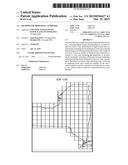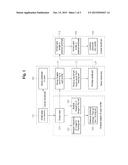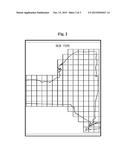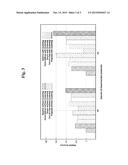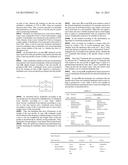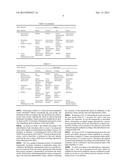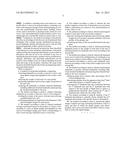Patent application title: METHOD FOR PROPOSING LANDMARK
Inventors:
Jong Hyun Han (Gwangju, KR)
Hyunju Lee (Gwangju, KR)
IPC8 Class: AG06Q5014FI
USPC Class:
707754
Class name: Database and file access preparing data for information retrieval filtering data
Publication date: 2015-10-15
Patent application number: 20150294427
Abstract:
Disclosed herein is a method for proposing landmarks including:
extracting digital images photographed in a country or area for a user to
visit; analyzing the weight of each item of a user profile containing
travel information of the user using the digital images; prioritizing
landmarks based on the weight of each item of the user profile in
landmark data extracted in a country to visit; and clustering the
landmarks to produce cluster landmarks including additional clustered
landmarks and proposing the cluster landmarks to the user. Thus,
according to the present invention, when planning a trip, a user can be
proposed travel spots which are suitable for the user's travel conditions
and are considered as landmarks in an area to visit without need for
retrieval of information from a vast database.Claims:
1. A method for proposing landmarks, comprising: extracting landmarks in
a country or area for a user to visit using digital images photographed
in the country or the area; analyzing the weight of each item of a user
profile; prioritizing landmarks based on the weight of each item of the
user; and clustering the landmarks to produce clustered landmarks
including additional clustered landmarks and proposing the clustered
landmarks to the user.
2. The method according to claim 1, wherein extracting landmarks in a country or area for a user to visit comprises: dividing the country or the area to visit into sectors having a predetermined size; and performing landmark scoring based on the frequency of the extracted digital images for each sector.
3. The method according to claim 2, wherein landmark scoring is performed based on the product of a factor corresponding to a ratio of digital images photographed in each sector to total digital images and a factor corresponding to a ratio of users having visited the sector to total users.
4. The method according to claim 1, wherein the user profile comprises at least one of information on a user home address, information on a season to visit, and information on a time of day to visit.
5. The method according to claim 1, wherein analyzing the weight of each item of the user profile comprises: randomly dividing the landmarks derived from the digital images into two groups to measure similarity of the user profiles of the groups; and prioritizing the items of the user profile based on the similarity.
6. The method according to claim 1, wherein prioritizing landmarks based on the weight of each item of the user is performed based on a landmark score vector according to the user profile.
7. The method according to claim 6, wherein the landmark score vector is derived by multiplication of a landmark score function according to a home address of the user, a landmark score function according to a season, and a landmark score function according to a time of day with a weight vector of the user profile.
8. The method according to claim 1, wherein clustering the landmarks to produce clustered landmarks including additional clustered landmarks and proposing the clustered landmarks to the user comprises: adding an empty set to a cluster value, and sorting a list of scored landmark data; determining whether, from the uppermost data, the jth landmark data belong to a specific cluster; and extracting the ith landmark data and, if similarity between the ith landmark data and the jth landmark data with respect to the user profile is higher than or equal to a predetermined threshold value, putting the ith and jth landmark data values into the cluster value.
9. The method according to claim 8, wherein, if the jth landmark data belong to a specific cluster, whether the j+1.sup.th landmark data belong to the specific cluster is determined.
10. The method according to claim 1, wherein the digital images comprise geo-tags containing information, such as a place and time at which the digital images were photographed, and a server associated with SNS is built as a database to extract the digital images.
Description:
CROSS REFERENCE TO RELATED APPLICATION
[0001] This application claims the benefit of Korean Patent Application No. 10-2014-0044481, filed on Apr. 14, 2014, entitled "METHOD FOR PROPOSING LANDMARK", which is hereby incorporated by reference in its entirety into this application.
BACKGROUND
[0002] 1. Technical Field
[0003] Embodiments of the invention relate to a method for proposing landmarks, and more particularly, to a method for proposing landmarks, in which landmarks are extracted according to user information to propose the most suitable landmark.
[0004] 2. Description of the Related Art
[0005] Recently, as smartphones become popular all over the world, use of digital images captured using built-in cameras of the smartphone is increasing and the images are posted on the Internet and SNS through mutual communication. Photos on a variety of topics are updated in real time all over the world. With increasing capacity of digital storage media, such digital images are stored in a server database to allow sharing between users.
[0006] When planning a trip to a certain country, a user tends to choose destinations with priority given to symbolic places or buildings of the country, or based on a specific travel theme such as visiting museums, watching night views, and the like. Here, a user generally makes a choice on the basis of digital images rather than written information.
[0007] To take a trip to a domestic area or a foreign country, a user usually connects to a website containing digital images of a destination and retrieves data therein. However, it takes long time to search a vast amount of digital image data. Thus, there is a problem in that a user has much difficulty in selecting or being proposed spots meeting user travel conditions.
BRIEF SUMMARY
[0008] Embodiment of the present invention have been conceived to solve such problems in the art and provide a method for proposing landmarks, which prioritizes travel spots suitable for a user based on a user profile including home address, season to visit, time of day to visit and travel theme, and proposes prioritized travel spots to the user, when the user plans a trip.
[0009] In accordance with one aspect of the present invention, a method for proposing landmarks may include: extracting landmarks in a country or area for a user to visit using digital images photographed in the country or the area; analyzing the weight of each item of a user profile; prioritizing landmarks based on the weight of each item of the user; and clustering the landmarks to produce clustered landmarks including additional clustered landmarks and proposing the clustered landmarks to the user.
[0010] In addition, extracting landmarks in a country or area for a user to visit may include: dividing an area to visit into sectors having a predetermined size; and performing landmark scoring based on the frequency of the extracted digital images for each sector.
[0011] The user profile may include at least one of information on a user home address, information on a season to visit, and information on a time of day to visit.
[0012] According to embodiments of the present invention, the method can propose travel spots, which suit user travel conditions and are considered as landmarks in an area to visit without retrieval of information from a vast database, to users when planning trips.
[0013] In addition, searching travel spots based on a user profile allows a user to be proposed places containing contents worth seeing for foreign visitors when the user plans an overseas trip; preferentially proposed places holding various events, such as festivities or sports events, based on a season to visit; and preferentially proposed places with a wonderful night view, and the like, based on a time of day to visit.
[0014] Furthermore, the method according to the embodiments of the invention has an advantage in that a user can be proposed other landmarks with a similar concept, distributed near the proposed landmarks, thereby allowing the user to visit all of the proposed landmarks within a given travel time.
BRIEF DESCRIPTION OF THE DRAWINGS
[0015] FIG. 1 is a flowchart showing a method for proposing landmarks according to one embodiment of the present invention.
[0016] FIG. 2 shows one example of sorting landmarks according to one embodiment of the present invention.
[0017] FIG. 3 is a graph showing relative accuracy of landmarks according to one embodiment of the present invention.
DETAILED DESCRIPTION
[0018] Hereinafter, exemplary embodiments of the invention will be described in detail with reference to the accompanying drawings. It should be understood that the present invention is not limited to the following embodiments and may be embodied in different ways. Detailed descriptions of functions or features known in the art will be omitted for clarity.
[0019] Embodiments of the present relate to a method for proposing landmarks to a user. A landmark is a conspicuous or distinguishing landscape feature marking a site or location and is thus suitable as a target for identifying a certain area, such as the N Seoul Tower, the Sungnyemun Gate, and the like. Such features of landmarks are obtained from their shapes, contrast against the background, excellence in spatial placement, and the like.
[0020] Every country has buildings or famous cultural assets which are used to promote the country. In a modern sense, representative monuments considered as symbols of certain areas, such as the Eiffel Tower in France, the Statue of Liberty in New York, and a pyramid in Egypt can be referred to as landmarks. Embodiments of the present invention are aimed at proposing such landmarks to a user who selects spots to visit upon planning a trip, thereby allowing the user to enrich travel content and easily make travel plans.
[0021] As used herein, a landmark may be defined as a digital image of a certain place. With the worldwide use of smartphones, digital images contain geo-tag information. Such digital images are posted to allow access of users around the world through an online community, such as an SNS.
[0022] In addition, on a certain Internet site, digital images are uploaded and shared by people on tour or people who have returned from their travels. In the embodiments, it is possible to build a database based on data stored in a server of the website. Such a database may contain digital images of tourist spots all over the world, and information such as places, dates, and time at or on which the digital images were photographed, are extracted by geo-tags of the digital images. The digital images may include certain places in a certain country for a user to visit, i.e. representative buildings, natural environments, cultural programs, and the like.
[0023] In the method according to the embodiments of the invention, a user can be proposed a country meeting user travel conditions or landmarks of a certain place when planning domestic travel through a user interface based on information of the database constructed as above. Hereinafter, the method for proposing landmarks according to the embodiments of the invention will be described in detail.
[0024] FIG. 1 is a flowchart showing a method for proposing landmarks according to one embodiment of the present invention.
[0025] Referring to FIG. 1, the method for proposing landmarks according to the embodiment of the invention may include extracting landmarks in a country or area to visit, analyzing the weight of each item of a user profile, selecting landmarks based on the user profile, and clustering the landmarks.
[0026] In the embodiment, a user is not proposed a landmark appearing most frequently in a country or area to visit, and proposed priorities derived from landmarks analyzed based on the user profile.
[0027] The user profile may include a user home address. In other words, whether a country chosen by the user is a foreign country or a home country is determined, whereby scoring for prioritizing travel spots can be changed.
[0028] In addition, the user profile may include information on a season to visit. When a user previously inputs information on a season to visit selected from spring, summer, fall, and winter, priorities of landmarks proposed to the user in a country to visit can be changed based on the season information.
[0029] Further, the user profile may include information on a time of day to visit a certain place. In other words, when a user previously inputs information on when the user will visit the place among morning, afternoon, evening, and night, the user can be proposed a landmark with highest priority for each time of day in a country to visit.
[0030] Hereinafter, the method for proposing landmarks according to the embodiment of the invention will be described in detail.
[0031] First, the method for proposing landmarks includes extracting landmarks in a country or area for a user to visit. Extracting landmarks may include dividing the country or area to visit into sectors (S10), and scoring landmarks for each sector (S20).
[0032] FIG. 2 is a view showing an example of sectionalizing landmarks in step S10. Referring to FIG. 2, for example, with New York divided into sectors having a predetermined size, scoring landmarks for each sector was performed. In scoring, the frequency of digital images for each sector was extracted. A sector having high frequency is a highly scored region, i.e. a section having lots of digital images produced by tourists.
[0033] Scoring landmarks for each sector may be represented by Equation 1:
LS ( region ) = ( photo ioc : loc .di-elect cons. region ) .A-inverted. photo × N ( user region ) N ( user ) ##EQU00001##
[0034] In other words, the landmark score LS for a region may be represented by the product of a factor corresponding to a ratio of digital images photographed in each sector (region) to total digital images (photos) and a factor corresponding to a ratio of users having visited the region to total users. As such, when one user has produced lots of digital images in that place, the ratio of users is taken into account, thereby making it possible to prevent landmarks in a certain place from being highly scored.
[0035] Next, the weight of each item of the user profile is analyzed. Here, an item of the user profile having the greatest effect on landmark scoring is determined. As described above, the user profile, i.e. items including information on a user home address, a season to visit, and a time of day to visit, are prioritized.
[0036] First, landmark data of an area obtained after step S10 of dividing the area into sectors are randomly divided into halves (D10). In step D10, the landmark data of the area are divided at random into training set data and test set data.
[0037] Then, the frequency of images in the training set data is analyzed (D20) and the frequency of images in the test set data is analyzed (D30), followed by measurement of similarity between the training set data and the test set data (D40).
[0038] Table 1 shows similarity between the training set data and the test set data according to season information of the user profile.
TABLE-US-00001 TABLE 1 Training Set Season Spring Summer Fall Winter Test Spring 0.9645 0.5799 0.5159 0.6091 Set Summer 0.5762 0.9593 0.5151 0.5321 Fall 0.5174 0.5258 0.9590 0.5940 Winter 0.5913 0.5406 0.5897 0.9535
[0039] Referring to Table 1, the training set and test set data exhibited a similarity of 95% or higher, when matched based on season, whereas the training set and test set data exhibited a similarity of 50% to 60%, when not matched based on season. Thus, it can be seen that it is desirable that information on a season to visit be considered in proposing landmarks.
TABLE-US-00002 TABLE 2 Training Set Time Morning Afternoon Evening Night Test Morning 0.9371 0.5853 0.4727 0.3753 Set Afternoon 0.5997 0.9683 0.5872 0.4542 Evening 0.4847 0.5814 0.9657 0.5537 Night 0.3728 0.4306 0.5364 0.9419
[0040] Referring to Table 2, the training set and test set data exhibited a similarity of 93% or higher, when matched based on time of day, whereas the training set and test set data exhibited a similarity of 37% to 60%, when not matched based on time of day. Thus, it can be seen that it is desirable that information on a time of day to visit the area be considered in proposing landmarks.
[0041] Similarly, for information on a user home address, when a user visiting New York is a New York resident, a high number of landmarks were measured in the suburbs of New York, whereas, when a user visiting New York is a foreigner, a high number of landmarks were measured in the center of New York. Thus, it can be seen that residence information must be considered, since a landmark score varies depending upon a home address of the user, i.e. whether the user is a foreigner or not.
[0042] As described above, in step D40, similarity according to each item of the user profile is measured to prioritize the items of the user profile in terms of effect on landmark scoring.
[0043] Then, landmarks suitable for the user are prioritized and selected. First, based on landmarks of the area obtained in step S20, digital images according to the user profile are grouped (L10). Next, a landmark score vector is produced from the training set data (L20). Equation 2 represents a landmark score vector produced according to the user profile.
LM ( h , s , d ) = ( LS hom ^ ( h ) LS sea ^ ( h ) LS pod ^ ( h ) ) ( w hom w hom + w sea + w pod w sea w hom + w sea + w pod w pod w hom + w sea + w pod ) [ Equation 2 ] ##EQU00002##
[0044] As described above, landmarks according to the user profile may be obtained by multiplication of a landmark score function according to a user home address (hom=home), a landmark score function according to a season to visit (sea=season) and a landmark score function according to a time of day to visit (pod=part of a day) with a weight vector of the user profile.
[0045] Thus, the landmark data have information on the weight of the user profile. In step L30, landmark results derived based on the frequency of digital images of an area for a user to visit are weighted by the weight value of the user profile as described above, thereby scoring landmarks. Then, landmarks corresponding to a user input value are prioritized.
[0046] Next, the method according to the embodiment may include clustering the landmark results determined in step L30.
[0047] After step L30, in step K10, spots similar to each of the derived landmarks are retrieved. For example, retrieval of the spots may be performed when a user inputs a travel spot and a travel time to a user interface. When the user inputs a travel time, the user is further proposed spots scored higher than or equal to a predetermined value in comparison with scores of landmarks selected to be suitable for the user.
[0048] In the method according to the embodiment, an algorithm for clustering landmarks is as follows.
[0049] First, an empty set is added to a cluster value, followed by sorting a list of scored landmark data. Then, whether, from the uppermost data of the list L, the jth landmark data belong to a specific cluster is determined. If the jth landmark data is included in the specific cluster, whether the j+1th landmark data belong to the specific cluster is determined.
[0050] Then, the ith landmark data are extracted. If similarity between the ith landmark data and the ith landmark date with respect to the user profile is higher than or equal to a predetermined threshold value, the ith and jth landmark data values are put into the cluster value. Thus, the cluster value may include a set of combined landmark data.
[0051] Then, in step K20, neighborhood spots proposed to a user as landmarks clustered near the selected landmarks are added.
[0052] In step K30, the landmarks are combined with one another and at least one clustered landmark result worth visiting is proposed to a user. Table 3 shows one example of clustered landmark results proposed to a user according to the user profile, as described above.
TABLE-US-00003 TABLE 3 Rank Baseline Home address Rank Baseline New York Other 1 Empire Brooklyn Empire State Building State Building (Madison square) (Madison square) 2 Times Square Union Rockefeller (Wall Street) Square Center (Washington Sq. (Statue of Liberty) Park) 3 Rockefeller Jersey City Time Square Center (Wall Street) (Statue of Liberty) 4 MOMA 4th Avenue Metropolitan Museum 5 Union Green MOMA Square Wood (Washington Sq. Park) Cemetery
TABLE-US-00004 TABLE 4 Rank Baseline Season Rank Baseline Spring Summer Fall Winter 1 Empire Union McCarren 4th Rockefeller State Building Square Park Avenue Center (Madison square) (Washington Pool (Statue of Sq. Liberty) Park) 2 Times Square MOMA MOMA Empire Times Square (Wall Street) State Building (Wall Street) (Madison square) 3 Rockefeller Museum of Times Square Rockefeller Times Square Center Natural (Wall Street) Center (Wall Street) (Statue of Liberty) History (Statue of Liberty) 4 MOMA Empire Empire New York Metropolitan State Building State Building Anime Museum (Madison (Madison Festival square) square) 5 Union Times Square Metropolitan MOMA Madison Square (Wall Street) Museum Square (Washington Sq. Park) Garden
TABLE-US-00005 TABLE 5 Rank Baseline Time of day Rank Baseline Morning Afternoon Evening Night 1 Empire 4th MOMA Empire Times Square State Building Avenue State Building (Wall Street) (Madison square) (Madison square) 2 Times Square Empire Union Times Square Rockefeller (Wall Street) State Building Square (Wall Street) Center (Madison (Washington (Statue of square) Sq. Park) Liberty) 3 Rockefeller Rockefeller Museum of Madison Nokia Center Center Natural Square Theater (Statue of Liberty) (Statue of History Garden (Broadway) Liberty) 4 MOMA Empire Empire Rockefeller Broadway State Building State Center (Madison Building (Statue of square) (Madison Liberty) square) 5 Union Times Square Metropolitan Metropolitan Empire Square (Wall Street) Museum Museum State Building (Washington Sq. Park) (Madison square)
[0053] Referring to Tables 3 to 5, there are shown landmark results (baseline) without considering the user profile and landmark results according to the user profile (home address, season, time of day). Specifically, there are shown clustered landmarks including a further proposed neighborhood spot. As shown in FIG. 3, priorities of landmarks proposed to a user vary depending upon conditions of the user profile.
[0054] As shown in Table 3, the method according to the embodiment of the invention allows a user to be proposed spots with a highly scored landmark according to season. For example, in summer, a swimming pool such as McCarren Park Pool is proposed, and, in fall, 4th Avenue holding various events, such as festivities, is proposed to the user, thereby allowing the user to enjoy much more traveling experiences when selecting travel spots.
[0055] FIG. 3 is a graph evaluating accuracy of a landmark metamodel. Accuracy evaluation is performed using cross validation. Specifically, experimental values in a specific section are removed from the entire experimental data having been used to produce a metamodel to reconstruct the metamodel, followed by calculating prediction values corresponding to the removed experimental values, thereby evaluating the accuracy of the metamodel based on difference in the prediction values and the removed experimental values.
[0056] Referring to FIG. 3, with landmark results not given the user profile fixed to 1, accuracy for each of the user profiles was analyzed. To use the metamodel as described above, information on digital images uploaded by a person having returned from travel and information on places proposed by her/him were assumed to be unknown, and results obtained using the method according to the embodiment were compared therewith.
[0057] As shown in FIG. 3, landmark results given the user profile and finally proposed results exhibited an accuracy greater than or equal to 1.2 times, and clustered results exhibited an accuracy of 1.6 times or move. Therefore, the method for proposing landmarks according to the embodiment of the invention can be evaluated to provide proposed spots with high reliability to a user.
[0058] As such, according to the embodiment, when planning a trip, a user can be proposed travel spots which are suitable for user travel conditions and are considered as landmarks in an area to visit without need for retrieval of information from a vast database.
[0059] In addition, searching travel spots based on a user profile allows a user to be proposed places containing contents worth seeing for foreign visitors when planning an overseas trip; preferentially proposed places holding various events, such as festivities or sporting events, based on a season to visit; and preferentially proposed places with a wonderful night view, and the like, based on a time of day to visit.
[0060] Furthermore, the method according to the embodiment has an advantage in that the user can be proposed other landmarks with a similar concept, distributed near the proposed landmarks, thereby allowing the user to visit all of the proposed landmarks within a given travel time.
[0061] Although the present invention has been described with reference to some exemplary embodiments, it should be understood that the foregoing embodiments are provided for illustration only and are not to be construed in any way as limiting the present invention, and that various modifications, changes, alterations, and equivalent embodiments can be made by those skilled in the art without departing from the spirit and scope of the invention. Therefore, the scope of the invention should be limited only by the accompanying claims and equivalents thereof.
User Contributions:
Comment about this patent or add new information about this topic:

